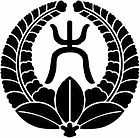Odawara Domain

Odawara Domain (小田原藩 Odawara-han) was a Japanese domain of the Edo period, located in western Sagami Province(modern-day Kanagawa Prefecture). It was centered on Odawara Castle in what is now the city of Odawara.
In the han system, Odawara was a political and economic abstraction based on periodic cadastral surveys and projected agricultural yields.[1] In other words, the domain was defined in terms of kokudaka, not land area.[2] This was different than the feudalism of the West.
History
Following the defeat of the Late Hōjō clan in the Battle of Odawara by the forces of Toyotomi Hideyoshi in 1590, their vast territories in the Kantō region were assigned to Tokugawa Ieyasu. Ieyasu selected Edo to be the headquarters of his new domains, and assigned his close retainer, Ōkubo Tadayo to rebuild Odawara Castle and to rule as a daimyō over the strategically important post town and to guard the approaches to Edo from the west via the Hakone Pass. Ōkubo Tadayo’s territory included 147 villages in Ashigarakami and Ashigarashimo districts with total revenues of 40,000 koku. His son Tadachika served in the Tokugawa shogunate as a rōjū and had his revenues increased by 20,000 koku with additional territories in Musashi Province.
The domain then passed to Abe Masatsugu, former castellan of Otaki Castle in Shimosa Province. After a four-year tenure, he was transferred to Iwatsuki Domain in Musashi and was replaced at Odawara by Inaba Masakatsu, formerly of Masaoka Domain in Shimotsuke Province. Masashige was the son of 3rd Tokugawa Shōgun Iemitsu’s wet nurse Kasuga no Tsubone and played an important role in the Tokugawa administration. His two sons ruled Odawara after his death, before being transferred to Takada Domain in Echigo Province.
Odawara then reverted to the Ōkubo clan, when Ōkubo Tadatomo was transferred from Sakura Domain in Kazusa Province. Tadatomo was the great-great-grandson of Ōkubo Tadayo, and the domain remained in the hands of his descendants until the Meiji Restoration.
In 1707, the Hōei eruption of Mount Fuji devastated much of the lands of the domain, and much of the original domain became tenryō under direct control of the Shōgunate, with Odawara Domain compensated by equivalent lands in other parts of Sagami, Musashi, Harima and Izu Province.
During the Bakumatsu period, the Shōgunate relied on troops from Odawara to maintain a guard on the increasing foreign presence in Izu Peninsula, particularly Shimoda and Heda.
After the Meiji Restoration, the final daimyō of Odawara, Ōkubo Tadayoshi surrendered his domain to the new Meiji government without resistance. After the abolition of the han system in July 1871, Odawara Domain became “Odawara Prefecture”, which merged with “Ogino-Yamanaka Prefecture” and part of “Niirayama Prefecture” in September 1871. In November of the same year, it merged into the short-lived Ashigara Prefecture.
List of daimyō
-
 Ōkubo clan (fudai) 1590-1614
Ōkubo clan (fudai) 1590-1614
| # | Name | Tenure | Courtesy title | Court Rank | revenues |
|---|---|---|---|---|---|
| 1 | Ōkubo Tadayo ( 大久保忠世) | 1590–1594 | unknown | unknown | 45,000 koku |
| 2 | Ōkubo Tadachika ( 大久保忠隣) | 1594–1614 | Sagami-no-kami | Lower 5th (従五位下) | 65,000 koku |
-
 Abe clan (fudai) 1619-1623
Abe clan (fudai) 1619-1623
| # | Name | Tenure | Courtesy title | Court Rank | revenues |
|---|---|---|---|---|---|
| 1 | Abe Masatsugu ( 阿部正次) | 1619–1623 | Bitchu-no-kami | Lower 4th (従四位下) | 50,000 koku |
-
 Inaba clan (fudai) 1632-1685
Inaba clan (fudai) 1632-1685
| # | Name | Tenure | Courtesy title | Court Rank | revenues |
|---|---|---|---|---|---|
| 1 | Inaba Masakatsu ( 稲葉正勝) | 1632–1634 | Tango-no-kami | Lower 5th (従五位下) | 85,000 koku |
| 2 | Inaba Masanori ( 稲葉正則) | 1634–1683 | Mimasaka-no-kami | Lower 4th (従四位下) | 85,000->102,000 koku |
| 3 | Inaba Masamichi ( 稲葉正往) | 1683–1685 | Tango-no-kami; Jiju | Lower 4th (従四位下) | 102,000 koku |
-
 Ōkubo clan (fudai) 1686-1871
Ōkubo clan (fudai) 1686-1871
| # | Name | Tenure | Courtesy title | Court Rank | revenues |
|---|---|---|---|---|---|
| 1 | Ōkubo Tadatomo ( 大久保忠朝) | 1686–1698 | Kaga-no-kami; Jiju | Lower 4th (従四位下) | 103,000->113,000 koku |
| 2 | Ōkubo Tadamasu ( 大久保忠増) | 1698–1713 | Kaga-no-kami | Lower 4th (従四位下) | 113,000 koku |
| 3 | Ōkubo Tadamasa ( 大久保忠方) | 1713–1732 | Kaga-no-kami | Lower 4th (従四位下) | 113,000 koku |
| 4 | Ōkubo Tadaoki ( 大久保忠興) | 1732–1763 | Okura Daiyu | Lower 4th (従四位下) | 113,000 koku |
| 5 | Ōkubo Tadayoshi ( 大久保忠由) | 1763–1769 | Kaga-no-kami | Lower 5th (従五位下) | 113,000 koku |
| 6 | Ōkubo Tadaaki ( 大久保忠顕) | 1769–1796 | Gon-Dainagon | Lower 5th (従五位下) | 113,000 koku |
| 7 | Ōkubo Tadazane ( 大久保忠真) | 1796–1837 | Kaga-no-kami; Jiju | Lower 4th (従四位下) | 113,000 koku |
| 8 | Ōkubo Tadanao ( 大久保忠愨) | 1837–1859 | Kaga-no-kami | Lower 4th (従四位下) | 113,000 koku |
| 9 | Ōkubo Tadanori ( 大久保忠礼) | 1859–1868 | Kaga-no-kami | Lower 5th (従五位下) | 113,000 koku |
| 10 | Ōkubo Tadayoshi ( 大久保忠良) | 1868–1871 | Kaga-no-kami | Lower 5th (従五位下) | 113,000 koku |
References
- ↑ Mass, Jeffrey P. and William B. Hauser. (1987). The Bakufu in Japanese History, p. 150.
- ↑ Elison, George and Bardwell L. Smith (1987). Warlords, Artists, & Commoners: Japan in the Sixteenth Century, p. 18.
Further reading
- Papinot, E (1910). Historical and Geographic Dictionary of Japan. Tuttle (reprint) 1972.
External links
- (Japanese) Odawara on "Edo 300 HTML"